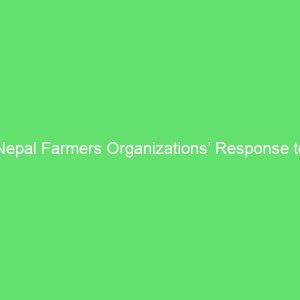Nepal was put on lockdown from 7 March to 7 May 2020. Starting 7 March, visa on arrival has been suspended for tourists/visitors. Only essential services were allowed to move, and only ambulance and transportation for basic needs like water and gas were allowed on the road. People were asked to stay home and go out only to buy food. The government also implemented safety measures such as social distancing.
When the lockdown was imposed, the situation has been under control when it comes to the pandemic, but as a small country situated between India and China, Nepal is vulnerable once there is an outbreak. With an open border with India where the number of cases is increasing and due to poverty and other problems, province no 1, province no. 2, province no. 5, Karnali, and province no. 7 are vulnerable. Due to the population and urban dwelling, Bagmati and Gandaki province are vulnerable, too. Food insecure mountainous Karnali can have havoc of the epidemic.
If the pandemic breaks out, families of 200-300 thousand farmers, agriculture workers, Dalit, and landless peasants will be affected. Dalits, daily wage-farm workers, and landless peasants, share-croppers in a large number are highly vulnerable with lack of food and resources due to the lockdown.
In Nepal, 65% of the total population relies on agriculture for their livelihood. According to the national agriculture census in 2011, the country has a total of 3,831,093, farmer families and out of that 51% are landless and smallholder farmer families who own less than 0.5 hectare of land. Most of the landless families are working as plowmen, domestic workers, and cattle grazers for their livelihood in the most of Terai districts. Moreover, those who are engaged in agriculture, have a hard time sustaining their livelihood for six months from their own production in normal situations.
Landless and small producers have been most vulnerable to the impacts of the COVID-19 pandemic. Most of them are also involved in informal sectors, working as daily wagers. After the government implemented the lockdown and quarantine, the agriculture and food supply chain has been greatly disrupted, with the small producers and poor consumers suffering badly. Smallholder farmers experienced food insufficiency. They lack access to basic primary healthcare and emergency medical needs is also another problem.
As it is the harvesting time for wheat, barley, lentils, potatoes, winter vegetables and it is also the sowing season for summer rice (chaite dhan) and summer vegetables when the lockdown was imposed, it became difficult for the people due to crop loss and other consequences. Farmers faced difficulties in bringing the fodder from the forest for their animals. Farmers were unable to sell their produce including highly perishable milk, vegetables, meat, eggs, poultry, etc. due to lack of transportation. Some were forced to sell their products at a cheap rate to suppliers that are relatively near to the city. The lockdown also prevented tea farmers from going to the fields and it also made the selling of tea difficult. Moreover, farmers faced difficulty in buying fertilizer and seeds.
To mitigate the effects of COVID-19, the National Land Rights Forum (NLRF) worked with the local government to loosen the lockdown on agriculture as it was the harvest season when the lockdown was imposed and soon monsoon season will make it difficult to harvest the produce. NLRF also provided food support to seven districts in Nepal. However, their biggest challenge while providing support is the lack of protective equipment.
NLRF and CSRC plan to work directly with local governments to provide help to at least 10 thousand vulnerable families in areas where the impact of the pandemic is felt badly. The support will include (1) provision of immediate economic relief (food and hygiene items) to most vulnerable families who are involved in agriculture as daily wage laborers, those who are without family, and those who are over 60 years, (2) provision of seeds and fertilizers to farmers so they can plant their crops timely, and (3) coordinating with the government for the marketing of agriculture sectors applying all safety precautions.
The National Peasants’ Coalition (NPC), Nepal has made a press release to demand support programs targeting peasants, farmers, and agriculture workers. The All Nepal Peasant Federation (ANPFa) also released a statement to draw the attention of the government towards providing immediate relief and support programs to compensate farmers, to ease the supply of food, feed/fodders, and facilitate the sale of vegetables, eggs, milk, and other agriculture produce. This resulted in the Government of Nepal declaring a 25% subsidy on the charges of milk transportation during the lockdown. ANPFa also facilitated the supply of food and suggested them for local selling of agri-produces or their post-harvest management (local processing). In spite of the limitations brought by the lockdown, ANPFa worked closely with all the three tiers of the government viz. federal, provincial, and local and facilitated connecting peasants’ and other people with them.
Meanwhile, NACCFL and other FOs also made their voice heard by releasing a statement to the press. FOs at the local level were connected to the farmers and they encouraged practicing safety measures for the prevention and control of COVID-19. The organization also facilitated selling agri-products locally and post-harvest processing of vegetables and other produce.
In Nepal, the importance of agriculture is felt during this time of crisis and people have started planting on barren lands.
In terms of support and aid, Nepal implemented a one-door policy for donations and distributions. All the relief was channeled to one government body/office and they were the ones distributing to the people. They have provided a food subsidy of 20 kilograms of rice and one-kilogram lentils. Nepal borrowed from World Bank to support the sectors of health and agriculture.

Comments are closed